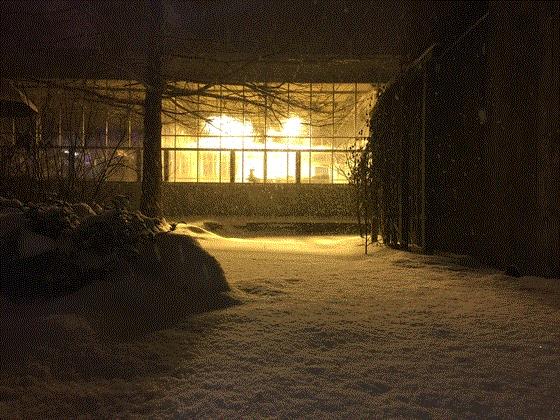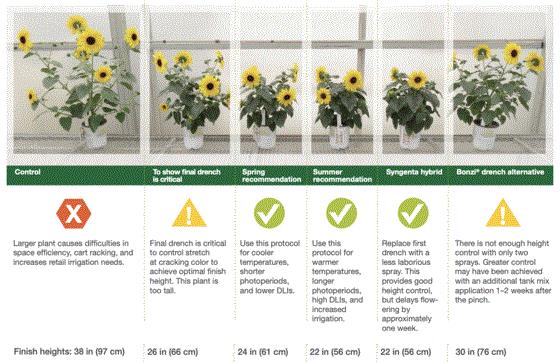NEW VIDEOS! Propagating & Finishing Vegetative Angelonia
The Tech On Team was back at it last week ... adding to our library of crop-specific videos. This time, the crop was vegetative angelonia and the expert was Ball Seed technical services specialist Josh Henry.
In VEGETATIVE ANGELONIA PROPAGATION—TEMPERATURE, LIGHT AND MORE, Josh joined me to share best management practices for propagation from unrooted cuttings. He takes the crop from receiving URCs and prioritization during busy weeks through all stages up until transplant. He covers research on optimum light levels, and tips for holding cuttings (if that’s necessary). In less than 15 minutes, you and your propagation team will pick up some great tips to optimize your Angelonia production this season.

The second new video takes Angelonia to the finish line—from transplant to shipping. In FINISHING VEGETATIVE ANGELONIA—PROMOTE BRANCHING AND AVOID BORON DEFICIENCY, Josh is back at it, sharing solid strategies for those of you growing vegetative angelonia. He covers the ins and outs of container selection, water management and lighting before going a bit deeper into nuances like the dangers of boron deficiency. Josh also gives plenty of tips for increasing branching using different methods.
Lastly, because we continue to share this information in any way you (or your team) choose to consume it, these two videos are available as podcast, as well. Be sure to subscribe to the Tech On Demand podcast on your favorite app so you never miss an episode. And this winter, why not jump back into the archives and get caught up—there are 160 episodes as of today!

Nick’s Tip of the Week: Your Cold-Weather Priorities
Each week, I’ll work with my buddy Nick Flax, a technical services expert at Ball, to share a concern that’s come up during one of his numerous calls with growers across North America. This week, he’s brushing the snow off his laptop and helping you and your teams prioritize tasks when winter weather turns nasty.
PROBLEM: Over the past couple of weeks, many of you have dealt with colder-than-usual conditions. While it’s generally advisable to overbuild your greenhouse infrastructure to account for seasonal extremes, the reality is that most greenhouses have just enough heating capacity (or a little bit more than they need) to get by under average local winter conditions.
If this sounds like your operation, it’s likely been difficult to maintain your greenhouses at the desired temperature setpoint. You may have asked yourself, “Are my crops going to be okay?”

NICK’S TIP: When your greenhouse is bleeding heat and your air temp setpoint won’t hold, do what you can to minimize risk of things like chilling or freezing injury and disease. Winterize your greenhouse as best you can using these excellent tips from MSU Extension and consider the following strategies to help protect crops on the bench:
Reduce Your Footprint
Unless your greenhouse is 100% full and spacing cannot be reduced, consider a temporary consolidation of crops into houses that hold heat better than others.
-
The glazing material on different greenhouses has a major impact on heat loss. Heat loss is generally highest in glass-glazed structures, slightly lower in rigid polycarbonate-glazed structures, and lowest in double poly greenhouses.
-
If it’s possible to temporarily move crops into a better-insulated structure without incurring chilling/freezing damage in the process, consider doing so. You'll be better equipped to keep crops at or above their lowest safe temperature, and it will take significantly less energy to heat a smaller footprint during extreme weather.
-
Once the cold weather passes, return crops to optimal spacing and environmental conditions. Don’t let temporary energy savings that you may have experienced during a cold snap go to your head. Keep your eyes on the prize: maximizing crop quality. Overly tight spacing for extended periods will only causes crops to become soft and leggy and encourage disease.
Use “Hot Spots” To Your Advantage
Every greenhouse has areas that stay warmer than other parts of the range—the hot spots. Use these areas to your advantage and put higher-value or chilling-injury-prone crops in these areas first.
-
Areas closest to your heat source like along heat pipes (for folks with radiant hot water/steam pipes), directly in the path of forced-air heaters or near insulated knee or curtain walls are prime real estate.
-
High-density and slower-growing seed and vegetative inputs (like freshly-sown plugs or recently-stuck unrooted cuttings (URCs)) should be top priority. Young plant crop failures will often hit your bottom line the hardest, and it may not be possible to source more URCs or finished plugs/liners for your desired planting timeframe.
-
High-value crops like tissue culture inputs, specialty tropicals and orchids should also receive priority when allocating hot-spot space.
-
Some cold calculus (pun intended) may be necessary if you're forced to dole out a finite amount of warmer bench. Consider letting faster-growing crops or less-expensive inputs bear the brunt of suboptimal temps, because they will be easier to replace if they ultimately fail.
Tent Young Plants To Help Slow Heat Loss
If possible, erect a temporary tent of poly film over young plants to further reduce the rate of heat loss. Warm air will stay trapped under the tent more easily and help to reduce the likelihood of cold damage to young plants.
This can be especially helpful if you have a bottom-heat stage (such as infrared heat mats, bench-top hot water tubes, or under-bench heat pipes/fin tubes).
-
If your only heat source is from a forced-air system above the bench, ensure that there is a direct path for warm air to enter the tent. Otherwise, it may become more difficult to keep temperatures warmer under the tent.
-
If you tent young plants, you'll need to adjust your mist/irrigation schedule. Humidity will remain high under the tent for longer periods, increasing the amount of time needed for the canopy and rootzone to dry down. Failure to adjust moisture management appropriately will result in increased disease pressure.

Nominate A Young Grower BY MARCH 1!
For the 21st year, GrowerTalks is awarding a deserving young (under the age of 35) grower with the coveted Young Grower Award for 2025. NOMINATON FORMS ARE NOW AVAILABLE! Feel free to nominate yourself, an employee, peer or friend. All nominations are due by March 1, 2025.
If garden center retail is your thing, Green Profit’s 20th Annual Young Retailer Award NOMINATION FORMS are also open and due by March 1.

Here are some more details about these prestigious awards:
-
We choose three finalists for each award, and each gets to write essay (a guest editorial, really) for the June issue of GrowerTalks and Green Profit based on a topic selected by our editors. (Here’s a link to the JUNE 2024 ESSAYS if you want to check out some examples.)
-
All six finalists are invited to attend Cultivate’25 in Columbus in July and attend dinner with editors, judges and sponsors before the awards ceremony.
-
The winners for each award are announced at the Cultivate ’25 Unplugged event for young professionals.
-
The winners will be featured on the covers of the September issue of GrowerTalks and Green Profit (achieving great fame and fortune—well maybe fame …) and will be a judge for next year’s award.
The future of our industry is inextricably linked to the quality of young professionally maintaining legacies, building businesses, changing paradigms and injecting new energy into horticulture—while staying grounded in the hard work and grit required to get the job done! These two awards are excellent ways to recognize the next movers and shakers in greenhouses and garden centers—but it’s up to you to identify and nominate them. Now’s your chance!
Last but not least, these awards come with plenty of opportunities for the finalists and winners (like travel to Cultivate, lodging, dinner, networking and more) so I would be remiss not to extend major thanks to all of the sponsors who support Ball Publishing and the awards. Shout out to Ball Horticultural Company, BASF and AmericanHort for sponsoring the Young Grower Award, and to The Garden Center Group, BASF and AmericanHort for supporting the Young Retailer Award!

PGR Protocols for Sunfinity YDC
A couple months ago, I recorded a comprehensive SUNFINITY VIDEO with Syngenta’s Dr. Jamie Gibson covering both the seed-raised Yellow Dark Center variety and original vegetative Sunfinity Double. They’re quite different in form (seed vs. vegetative) and how they’re produced in greenhouses, and Jamie discussed both in detail, including a bunch of nuances to watch for and best practices to remember when adding these sunflowers to your mix.

Recently, I extracted a short clip from this video because I know there’s a specific question that growers tend to ask when putting together production plans for the seed version—Sunfinity Yellow Dark Center (YDC).
The team at Syngenta has conducted extensive research and trials to nail down the specific PGR regimes to hit the exact specs you and your retail or landscape customers need. Jamie covered this in the video, but it was about halfway through the 50-minute presentation, and I thought it would be super-handy to have on its own. Check out PGR PROTOCOLS FOR SYNGENTA’S SUNFINITY YELLOW DARK CENTER … it’s a six-minute clip that will help you achieve the specs your customers require.
Here are a couple other awesome resources from Syngenta that will help your Sunfinity YDC PGR planning:

Assessing Overwintered Perennials
Freezing temperatures in winter always drive up the chatter level in our industry—frozen or delayed shipments of URCs, greenhouse damage and heater issues, rodents and plenty more frustrations seem to arise when the mercury drops toward 0F. Nick covered a ton in his tech tip above, based on his interactions with growers (and his own greenhouse experience) over the years.
I looked to another expert for thoughts specific to perennials crops currently overwintering at North American greenhouses and nurseries. I figured prolonged freezing temps in winter could cause some challenges, and I wanted to help those of you growing perennials pick up some ideas before waking them up in the spring.

Of course, I turned to my fellow newsletter editor and all-around perennials guru Paul Pilon and immediately found an appropriate article to share. He wrote DID YOU KILL THEM? all the way back in 2017 in an effort to help folks quickly assess if their perennials survived the overwintering period. He explained the transition from cold winter temps to warmer spring weather is where most losses occur. Poor root systems and inadequate (or variable) moisture levels lead to crop struggles, but temperature fluctuations are the main culprit.
Paul shared these thoughts on damage related to temperature fluctuation:
-
This type of damage frequently occurs inside structures with no heat source and/or facilities that cannot be properly ventilated during the day. The injury and losses appear sporadic throughout the crop and have no defined patterns (the losses aren’t just along the outsides of the blocks as described above). As the plants de-acclimate and begin to emerge, they’re most susceptible to cold injury. It’s very important to provide protection from cold, either with coverings or by providing minimal heat when the temperatures are below freezing at this stage.
-
During the late winter, keep the temperatures inside the structures as cool as possible. This will delay de-acclimation and keep the plants from growing too early. This takes a little effort, unless environmental controls can be utilized. For many growers, this entails opening and closing doors manually each day.
-
A good strategy during the late winter would be to keep the doors open any time the outside temperatures are above 30F (-1C). When the temperatures are expected to fall below 30F again, shut the doors again. Keeping the plants as cold as possible keeps them acclimated longer.
Assessing Perennial Health in Spring—tips from Paul:
-
Checking the root system is the first step to verify that a plant survived the winter. Ideally, the roots should be firm and have consistent coloration (lack of light and dark areas). Any variability in coloration could indicate that cold damage has occurred, or the roots were under attack from pathogens prior to being overwintered. In most cases, root rots do not occur during the winter months since the temperatures are too cold for pathogen activity.
-
Don’t just look at the roots though. It’s more important to check the health of the crowns. Look for any new buds or stems developing near the soil line. If no growth can be seen, then gently dig below the surface and locate the crown of the plants. The crown should be firm, not soft or mushy. In most cases, cold damage has occurred when the crown is soft; these plants often don’t survive.
-
If some root discoloration or crown damage is detected, consider applying a broad-spectrum fungicide drench that targets several plant pathogens, including Fusarium, Phytophthora, Pythium and Rhizoctonia. The fungicide application is most effective when the soil temperatures are 50F (10C) or warmer; this is when the pathogens will also be active. Applying fungicides when it’s too cold for pathogen activity won’t provide the amount of disease control as they do with warmer temperatures.

Finish Line—Links to Guides
As we get further into the new year and greenhouses start filling up, I thought it would be a good time to remind you about GrowerTalks’ Grower Guides. Over the years, these have all become important tools for many of you, and thanks to our partners and sponsors, they’re updated regularly to stay cutting-edge and relevant—adding new products and the latest techniques.
I always want to make sure you have the latest editions of these resources close at hand to make your greenhouse detective work and strategies as efficient as possible. Whether you’re trying to figure out how best to apply plant growth regulators (PGRs) on your annual or perennial crops (and even which ones to use) or about to battle with persistent greenhouse pests, Ball Publishing has you covered.
Here are four you need to bookmark and share:
PLANT GROWTH REGULATORS FOR ANNUALS
With the expansion of PGR options, as well as new chemistries to control and expand growth, encourage branching and even new application methods, staying up to speed on these solutions is as critical as ever. The guide covers specific crops like hanging baskets, poinsettias and more, as well as sharing an overview of just about every PGR on the market.
GROWTH REGULATORS FOR CONTAINERIZED HERBACEOUS PERENNIAL PLANTS
Like the annuals guide, this one covers some crop specifics, new research findings and how you can use them in your greenhouse, as well as a comprehensive overview of chemistries. If you grow perennials and you haven’t yet seen this guide, I can pretty much guarantee you’ll be blown away by the amount of information.
INSECTICIDE, MITICIDE & FUNGICIDE GUIDE
The title says it all … this guide is packed with information your entire team needs to grow the best crops possible, with the fewest issues. From shoot to root, some of the top researchers in the industry share detailed information on a wide range of greenhouse challenges from specific bugs to the most wicked pathogens. There are plenty of charts to reference, addressing greenhouse and nursery fungicides, as well as a thorough list of pesticides. It’s also available in SPANISH!
BIOSOLUTIONS GUIDE
Biosolutions are critical ingredients in most growers’ recipes for crop quality. Our industry is evolving quickly, and new research, information and products in the biosolution space is coming available at equal speed. If you’re interested in pest and disease management, plant health optimization, labor savings and improved worker safety, this new guide will be a valuable resource. In its 30-plus pages, you can expect to find tons of hard data (check out the updated biofungicide and bioinsecticide charts), fresh approaches and proven strategies.
Until next week, stay warm and stay focused!




Please feel free to send your comments, constructive criticism and topic ideas to me at bcalkins@ballhort.com.

Bill Calkins
Editor - Tech On Demand
This email was received by you and 25,692 other fine subscribers!
If you're interested in advertising in Tech On Demand, contact Kim Brown ASAP and she'll hook you up.